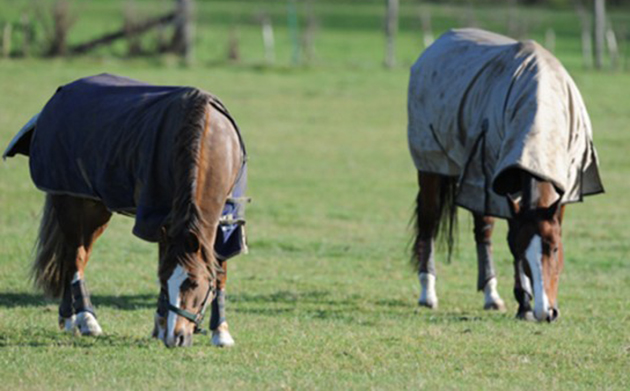Rebecca Hamilton-Fletcher MRCVS discusses the welfare rules surrounding horses for hire
RIDING establishments are an integral and much-loved part of British equestrianism. Many of us started our equestrian “journey” at the local riding school, and these establishments play a vital role in ensuring that riding remains accessible to all.
Even at the best of times, however, managing a riding establishment involves immense hard work with minimal financial return. Covid-19 has added to this somewhat precarious existence.
As restrictions are lifted, establishments that have survived are preparing for a busy summer. How do these businesses routinely manage the health and welfare of their animals?
{"content":"PC9wPgo8aDM+U1RSSUNUIFNUQU5EQVJEUzwvaDM+CjxwPkEgUklESU5HIGVzdGFibGlzaG1lbnQgKFJFKSBpcyBhbnkgYnVzaW5lc3MgdGhhdCBoaXJlcyBvdXQgaG9yc2VzIGZvciByaWRpbmcgb3IgaW5zdHJ1Y3Rpb24gaW4gcmlkaW5nLCBvciBib3RoLiBJbiBhZGRpdGlvbiB0byByaWRpbmcgc2Nob29scywgUkVzIGluY2x1ZGUgb3BlcmF0aW9ucyBzdWNoIGFzIHRyZWtraW5nIGNlbnRyZXMgYW5kIHBvbG8gc2Nob29scywgYW5kIHRob3NlIG9mZmVyaW5nIGh1bnRlciBoaXJlbGluZ3MgYW5kIGJlYWNoIGRvbmtleXMuIEEgcmFmdCBvZiBsZWdpc2xhdGlvbiBpbiBwbGFjZSBpcyB1bmRlcnBpbm5lZCBieSB0aGUgQW5pbWFsIFdlbGZhcmUgQWN0IDIwMDYsIHRvIHByb3RlY3QgdGhlIHdlbGZhcmUgb2YgdGhlIGFuaW1hbHMgdXNlZCBhbmQgdGhlIGhlYWx0aCBhbmQgc2FmZXR5IG9mIGNsaWVudHMgYW5kIGVtcGxveWVlcy48L3A+CjxwPjxkaXYgY2xhc3M9ImFkLWNvbnRhaW5lciBhZC1jb250YWluZXItLW1vYmlsZSI+PGRpdiBpZD0icG9zdC1pbmxpbmUtMiIgY2xhc3M9ImlwYy1hZHZlcnQiPjwvZGl2PjwvZGl2PjxzZWN0aW9uIGlkPSJlbWJlZF9jb2RlLTMxIiBjbGFzcz0iaGlkZGVuLW1kIGhpZGRlbi1sZyBzLWNvbnRhaW5lciBzdGlja3ktYW5jaG9yIGhpZGUtd2lkZ2V0LXRpdGxlIHdpZGdldF9lbWJlZF9jb2RlIHByZW1pdW1faW5saW5lXzIiPjxzZWN0aW9uIGNsYXNzPSJzLWNvbnRhaW5lciBsaXN0aW5nLS1zaW5nbGUgbGlzdGluZy0tc2luZ2xlLXNoYXJldGhyb3VnaCBpbWFnZS1hc3BlY3QtbGFuZHNjYXBlIGRlZmF1bHQgc2hhcmV0aHJvdWdoLWFkIHNoYXJldGhyb3VnaC1hZC1oaWRkZW4iPg0KICA8ZGl2IGNsYXNzPSJzLWNvbnRhaW5lcl9faW5uZXIiPg0KICAgIDx1bD4NCiAgICAgIDxsaSBpZD0ibmF0aXZlLWNvbnRlbnQtbW9iaWxlIiBjbGFzcz0ibGlzdGluZy1pdGVtIj4NCiAgICAgIDwvbGk+DQogICAgPC91bD4NCiAgPC9kaXY+DQo8L3NlY3Rpb24+PC9zZWN0aW9uPjwvcD4KPHA+QWxsIFJFcyBhcmUgcmVxdWlyZWQgdG8gYmUgbGljZW5zZWQuIFRoaXMgaW52b2x2ZXMgYSByaWdvcm91cyBhbm51YWwgaW5zcGVjdGlvbiB3aGljaCBtdXN0IGJlIGNhcnJpZWQgb3V0IGJ5IGEgdHJhaW5lZCBhbmQgbGlzdGVkIHZldGVyaW5hcnkgaW5zcGVjdG9yLCBvZnRlbiB3aXRoIGEgbG9jYWwgYXV0aG9yaXR5IGluc3BlY3Rvci48L3A+CjxwPlN0cmljdCBtaW5pbXVtIHN0YW5kYXJkcyBtdXN0IGJlIG1ldCBmb3IgYSBsaWNlbmNlIHRvIGJlIGlzc3VlZCBvciByZW5ld2VkLiBBbnkgYW5pbWFscyBkZWVtZWQgbm90IHN1aXRhYmxlIOKAkyB0aG9zZSB0aGF0IGFyZSB1bnNvdW5kLCBmb3IgZXhhbXBsZSDigJMgd2lsbCBub3QgYmUgaW5jbHVkZWQgb24gdGhlIGxpY2VuY2UgYXQgdGhpcyBzdGFnZS4gSW4gRW5nbGFuZCwgd2hlcmUgYWRkaXRpb25hbCByZWd1bGF0aW9ucyBtYW5kYXRlIGV4dHJhIGNyaXRlcmlhIGJlIG1ldCwgYSBzdGFyIHJhdGluZyBzeXN0ZW0gcmV3YXJkcyBSRXMgb2YgYSBwYXJ0aWN1bGFybHkgaGlnaCBzdGFuZGFyZC48L3A+CjxwPjxpbWcgZmV0Y2hwcmlvcml0eT0iaGlnaCIgZGVjb2Rpbmc9ImFzeW5jIiBjbGFzcz0ibGF6eWxvYWQgYmx1ci11cCBhbGlnbm5vbmUgc2l6ZS1mdWxsIHdwLWltYWdlLTc0MjQyOCIgZGF0YS1wcm9jZXNzZWQgc3JjPSJodHRwczovL2tleWFzc2V0cy50aW1laW5jdWsubmV0L2luc3BpcmV3cC9saXZlL3dwLWNvbnRlbnQvdXBsb2Fkcy9zaXRlcy8xNC8yMDE3LzAzL25ldy1oaC1wbGFjZWhvbGRlci0yMDB4MjAwLnBuZyIgZGF0YS1zcmM9Imh0dHBzOi8va2V5YXNzZXRzLnRpbWVpbmN1ay5uZXQvaW5zcGlyZXdwL2xpdmUvd3AtY29udGVudC91cGxvYWRzL3NpdGVzLzE0LzIwMjEvMDQvSEFIMzAwLnZldF8uZjExbjdtX2FsYW15LmpwZyIgYWx0PSJGMTFON00gUmlkaW5nIGxlc3NvbiBpbiBhIHJpZGluZyBoYWxsIiB3aWR0aD0iMTQwMCIgaGVpZ2h0PSI3ODgiIGRhdGEtc2l6ZXM9ImF1dG8iIGRhdGEtc3Jjc2V0PSJodHRwczovL2tleWFzc2V0cy50aW1laW5jdWsubmV0L2luc3BpcmV3cC9saXZlL3dwLWNvbnRlbnQvdXBsb2Fkcy9zaXRlcy8xNC8yMDIxLzA0L0hBSDMwMC52ZXRfLmYxMW43bV9hbGFteS5qcGcgMTQwMHcsIGh0dHBzOi8va2V5YXNzZXRzLnRpbWVpbmN1ay5uZXQvaW5zcGlyZXdwL2xpdmUvd3AtY29udGVudC91cGxvYWRzL3NpdGVzLzE0LzIwMjEvMDQvSEFIMzAwLnZldF8uZjExbjdtX2FsYW15LTMwMHgxNjkuanBnIDMwMHcsIGh0dHBzOi8va2V5YXNzZXRzLnRpbWVpbmN1ay5uZXQvaW5zcGlyZXdwL2xpdmUvd3AtY29udGVudC91cGxvYWRzL3NpdGVzLzE0LzIwMjEvMDQvSEFIMzAwLnZldF8uZjExbjdtX2FsYW15LTYzMHgzNTUuanBnIDYzMHcsIGh0dHBzOi8va2V5YXNzZXRzLnRpbWVpbmN1ay5uZXQvaW5zcGlyZXdwL2xpdmUvd3AtY29udGVudC91cGxvYWRzL3NpdGVzLzE0LzIwMjEvMDQvSEFIMzAwLnZldF8uZjExbjdtX2FsYW15LTEzNXg3Ni5qcGcgMTM1dywgaHR0cHM6Ly9rZXlhc3NldHMudGltZWluY3VrLm5ldC9pbnNwaXJld3AvbGl2ZS93cC1jb250ZW50L3VwbG9hZHMvc2l0ZXMvMTQvMjAyMS8wNC9IQUgzMDAudmV0Xy5mMTFuN21fYWxhbXktMzIweDE4MC5qcGcgMzIwdywgaHR0cHM6Ly9rZXlhc3NldHMudGltZWluY3VrLm5ldC9pbnNwaXJld3AvbGl2ZS93cC1jb250ZW50L3VwbG9hZHMvc2l0ZXMvMTQvMjAyMS8wNC9IQUgzMDAudmV0Xy5mMTFuN21fYWxhbXktNjIweDM0OS5qcGcgNjIwdywgaHR0cHM6Ly9rZXlhc3NldHMudGltZWluY3VrLm5ldC9pbnNwaXJld3AvbGl2ZS93cC1jb250ZW50L3VwbG9hZHMvc2l0ZXMvMTQvMjAyMS8wNC9IQUgzMDAudmV0Xy5mMTFuN21fYWxhbXktOTIweDUxOC5qcGcgOTIwdywgaHR0cHM6Ly9rZXlhc3NldHMudGltZWluY3VrLm5ldC9pbnNwaXJld3AvbGl2ZS93cC1jb250ZW50L3VwbG9hZHMvc2l0ZXMvMTQvMjAyMS8wNC9IQUgzMDAudmV0Xy5mMTFuN21fYWxhbXktMTIyMHg2ODcuanBnIDEyMjB3IiBzaXplcz0iKG1heC13aWR0aDogMTQwMHB4KSAxMDB2dywgMTQwMHB4IiAvPjwvcD4KPGRpdiBjbGFzcz0iYWQtY29udGFpbmVyIGFkLWNvbnRhaW5lci0tbW9iaWxlIj48ZGl2IGlkPSJwb3N0LWlubGluZS0zIiBjbGFzcz0iaXBjLWFkdmVydCI+PC9kaXY+PC9kaXY+CjxwPkluc3BlY3Rpb24gb2YgdGhlIGhvcnNlcyBpcyB3ZWxmYXJlLWRyaXZlbiBhbmQgZm9jdXNlcyBvbiB0aG9zZSBhcmVhcyBtb3N0IGF0IHJpc2ssIGVzcGVjaWFsbHkgZ2l2ZW4gdGhhdCBtYW55IFJFcyBmYXZvdXIgb2xkZXIgYW5pbWFscy4gQW55IGp1ZGdlbWVudHMgbWFkZSBhcmUgYWx3YXlzIGluIHRoZSBjb250ZXh0IG9mIHRoZSBhbmltYWzigJlzIHJvbGU7IHdpbGwgaGUgYmUgaHVudGluZyB0d2ljZSBhIHdlZWssIG9yIGlzIGhlIGEgUmlkaW5nIGZvciB0aGUgRGlzYWJsZWQgQXNzb2NpYXRpb24gcG9ueSBhbmQgb25seSBldmVyIHJlcXVpcmVkIHRvIHdhbGsgc3RlYWRpbHkgYXJvdW5kIHRoZSBzY2hvb2w\/PC9wPgo8cD5IZWFsdGggcmVjb3JkcyBtdXN0IGJlIGtlcHQgZm9yIGV2ZXJ5IGhvcnNlIG9yIHBvbnksIGRldGFpbGluZyB0aGUgcm91dGluZSBtb25pdG9yaW5nIG9mIGhpcyB3ZWlnaHQgYW5kIGNvbmRpdGlvbiBzY29yZSwgYWxvbmcgd2l0aCBkZW50aXN0cnksIHdvcm1pbmcsIGZhcnJpZXJ5IGFuZCB0YWNrIGNoZWNrcywgYW5kIGFueSBoZWFsdGggcHJvYmxlbXMgb3Igbm9uLXJvdXRpbmUgdmV0ZXJpbmFyeSB0cmVhdG1lbnQuPC9wPgo8ZGl2IGNsYXNzPSJhZC1jb250YWluZXIgYWQtY29udGFpbmVyLS1tb2JpbGUiPjxkaXYgaWQ9InBvc3QtaW5saW5lLTQiIGNsYXNzPSJpcGMtYWR2ZXJ0Ij48L2Rpdj48L2Rpdj4KPHA+VGhlIHZldGVyaW5hcnkgaW5zcGVjdGlvbiBjb25jZW50cmF0ZXMgb24ga2V5IGFyZWFzOjwvcD4KPHA+R2VuZXJhbCBjb25kaXRpb246IGlzIHRoZSBhbmltYWwgaW4gb3B0aW11bSBjb25kaXRpb24gZm9yIGhpcyB3b3JrbG9hZD8gTWFueSB0cmFkaXRpb25hbCBSRXMgdXNlIG5hdGl2ZSBwb255IHR5cGVzLCBwcm9uZSB0byBnYWluaW5nIGV4Y2VzcyB3ZWlnaHQuPC9wPgo8ZGl2IGNsYXNzPSJhZC1jb250YWluZXIgYWQtY29udGFpbmVyLS1tb2JpbGUiPjxkaXYgaWQ9InBvc3QtaW5saW5lLTUiIGNsYXNzPSJpcGMtYWR2ZXJ0Ij48L2Rpdj48L2Rpdj4KPHA+QXBwZWFyYW5jZSBhbmQgZGVtZWFub3VyOiBhIOKAnGhhcHB54oCdIGFuaW1hbCBzcGVha3Mgdm9sdW1lcy48L3A+CjxwPk11c2N1bG9za2VsZXRhbCBzeXN0ZW06IGl0IGlzIGltcG9ydGFudCB0byBkaWZmZXJlbnRpYXRlIGJldHdlZW4gYSBkZWdyZWUgb2YgaW5pdGlhbCBzdGlmZm5lc3MsIHdoaWNoIG1heSBiZSBhY2NlcHRhYmxlLCBhbmQgb2J2aW91cyBsYW1lbmVzcy4gQSBnb29kIG92ZXJhbGwgc3RhbmRhcmQgb2YgZm9vdGNhcmUgaXMgYWxzbyByZXF1aXJlZC48L3A+CjxwPkJhY2sgaGVhbHRoOiBhbnkgZXZpZGVuY2Ugb2YgYSBzb3JlIGJhY2sgd2FycmFudHMgY2FyZWZ1bCBhc3Nlc3NtZW50IG9mIGJvdGggdGhlIHNhZGRsZSBmaXQgYW5kIHRoZSBSReKAmXMgcG9saWN5IGZvciBob3JzZTpyaWRlciBib2R5d2VpZ2h0IHJhdGlvcy48L3A+CjxwPkV5ZXMgYW5kIGhlYXJ0OiBjYXRhcmFjdHMgYW5kIG90aGVyIHZpc3VhbCBpc3N1ZXMgYXJlIGNvbW1vbiBmaW5kaW5ncyB3aXRoaW4gYW4gb2xkZXIgZXF1aW5lIHBvcHVsYXRpb24uIE1vc3QgYW5pbWFscyBzZWVtIHRvIHdvcmsgbm9ybWFsbHkgd2l0aCBhIGRlZ3JlZSBvZiB2aXN1YWwgaW1wYWlybWVudCwgYnV0IHJpZGVyIHNhZmV0eSBpcyBwYXJhbW91bnQuIEl0IG1heSBiZSBuZWNlc3NhcnkgdG8gaW1wb3NlIHJlc3RyaWN0aW9ucywgc3VjaCBhcyBubyByb2Fkd29yay4gSGVhcnQgbXVybXVycyBhcmUgZ2VuZXJhbGx5IGxlc3Mgb2YgYSBjb25jZXJuIGluIGFuIG90aGVyd2lzZSBoZWFsdGh5IGFuaW1hbCwgYnV0IHJlcXVpcmUgY2FyZWZ1bCBtb25pdG9yaW5nLjwvcD4KPHA+Q29hdCBhbmQgc2tpbjogaWRlYWxseSBhbiBhbmltYWwgaGFzIGEgd2VsbC1ncm9vbWVkLCBoZWFsdGh5IGNvYXQsIHdpdGggbm8gc2lnbiBvZiBhYnJhc2lvbnMgb3IgZ2FsbHMuPC9wPgo8cD5UYWNrOiB0aGlzIHNob3VsZCBiZSBjbGVhbiBhbmQgd2VsbCBtYWludGFpbmVkLiBIb3JzZXMgYXJlIGluc3BlY3RlZCB0YWNrZWQgdXAsIHdpdGggYXR0ZW50aW9uIHBhaWQgdG8gY29ycmVjdCBmaXQsIHNhZmV0eSBhbmQgZ2VuZXJhbCB3ZWFyIGFuZCB0ZWFyLjwvcD4KPHA+PGltZyBkZWNvZGluZz0iYXN5bmMiIGNsYXNzPSJsYXp5bG9hZCBibHVyLXVwIGFsaWdubm9uZSBzaXplLWZ1bGwgd3AtaW1hZ2UtNzQyNDI2IiBkYXRhLXByb2Nlc3NlZCBzcmM9Imh0dHBzOi8va2V5YXNzZXRzLnRpbWVpbmN1ay5uZXQvaW5zcGlyZXdwL2xpdmUvd3AtY29udGVudC91cGxvYWRzL3NpdGVzLzE0LzIwMTcvMDMvbmV3LWhoLXBsYWNlaG9sZGVyLTIwMHgyMDAucG5nIiBkYXRhLXNyYz0iaHR0cHM6Ly9rZXlhc3NldHMudGltZWluY3VrLm5ldC9pbnNwaXJld3AvbGl2ZS93cC1jb250ZW50L3VwbG9hZHMvc2l0ZXMvMTQvMjAyMS8wNC9IQUgzMDAudmV0Xy5kajFoaHdfYWxhbXktMS5qcGciIGFsdD0iREoxSEhXIERvbWVzdGljIGhvcnNlIFNhZGRsZSBzb3JlIiB3aWR0aD0iMTQwMCIgaGVpZ2h0PSI3ODgiIGRhdGEtc2l6ZXM9ImF1dG8iIGRhdGEtc3Jjc2V0PSJodHRwczovL2tleWFzc2V0cy50aW1laW5jdWsubmV0L2luc3BpcmV3cC9saXZlL3dwLWNvbnRlbnQvdXBsb2Fkcy9zaXRlcy8xNC8yMDIxLzA0L0hBSDMwMC52ZXRfLmRqMWhod19hbGFteS0xLmpwZyAxNDAwdywgaHR0cHM6Ly9rZXlhc3NldHMudGltZWluY3VrLm5ldC9pbnNwaXJld3AvbGl2ZS93cC1jb250ZW50L3VwbG9hZHMvc2l0ZXMvMTQvMjAyMS8wNC9IQUgzMDAudmV0Xy5kajFoaHdfYWxhbXktMS0zMDB4MTY5LmpwZyAzMDB3LCBodHRwczovL2tleWFzc2V0cy50aW1laW5jdWsubmV0L2luc3BpcmV3cC9saXZlL3dwLWNvbnRlbnQvdXBsb2Fkcy9zaXRlcy8xNC8yMDIxLzA0L0hBSDMwMC52ZXRfLmRqMWhod19hbGFteS0xLTYzMHgzNTUuanBnIDYzMHcsIGh0dHBzOi8va2V5YXNzZXRzLnRpbWVpbmN1ay5uZXQvaW5zcGlyZXdwL2xpdmUvd3AtY29udGVudC91cGxvYWRzL3NpdGVzLzE0LzIwMjEvMDQvSEFIMzAwLnZldF8uZGoxaGh3X2FsYW15LTEtMTM1eDc2LmpwZyAxMzV3LCBodHRwczovL2tleWFzc2V0cy50aW1laW5jdWsubmV0L2luc3BpcmV3cC9saXZlL3dwLWNvbnRlbnQvdXBsb2Fkcy9zaXRlcy8xNC8yMDIxLzA0L0hBSDMwMC52ZXRfLmRqMWhod19hbGFteS0xLTMyMHgxODAuanBnIDMyMHcsIGh0dHBzOi8va2V5YXNzZXRzLnRpbWVpbmN1ay5uZXQvaW5zcGlyZXdwL2xpdmUvd3AtY29udGVudC91cGxvYWRzL3NpdGVzLzE0LzIwMjEvMDQvSEFIMzAwLnZldF8uZGoxaGh3X2FsYW15LTEtNjIweDM0OS5qcGcgNjIwdywgaHR0cHM6Ly9rZXlhc3NldHMudGltZWluY3VrLm5ldC9pbnNwaXJld3AvbGl2ZS93cC1jb250ZW50L3VwbG9hZHMvc2l0ZXMvMTQvMjAyMS8wNC9IQUgzMDAudmV0Xy5kajFoaHdfYWxhbXktMS05MjB4NTE4LmpwZyA5MjB3LCBodHRwczovL2tleWFzc2V0cy50aW1laW5jdWsubmV0L2luc3BpcmV3cC9saXZlL3dwLWNvbnRlbnQvdXBsb2Fkcy9zaXRlcy8xNC8yMDIxLzA0L0hBSDMwMC52ZXRfLmRqMWhod19hbGFteS0xLTEyMjB4Njg3LmpwZyAxMjIwdyIgc2l6ZXM9IihtYXgtd2lkdGg6IDE0MDBweCkgMTAwdncsIDE0MDBweCIgLz48L3A+CjxoMz5DT01QTEVYIENIQUxMRU5HRVM8L2gzPgo8cD5XSElMRSBtdWNoIG9mIHRoaXMgbWF5IGFwcGVhciBzdHJhaWdodGZvcndhcmQgdG8gdGhlIGluZGl2aWR1YWwgaG9yc2Ugb3duZXIsIHRoZSBtYW55IHZhcmlhYmxlcyB3aXRoaW4gYW4gUkXigJlzIHJlbWl0IGFkZCBmdXJ0aGVyIGNvbXBsZXhpdHkgdG8gdGhlIG1hbmFnZW1lbnQgY2hhbGxlbmdlcyDigJMgYW5kIGFsc28gdG8gdGhlIHdvcmtsb2FkIG9mIHRoZSBhbmltYWxzIGludm9sdmVkLjwvcD4KPHA+VmFyeWluZyBsZXZlbHMgb2YgZml0bmVzcyBtYXkgYmUgcmVxdWlyZWQsIGZvciBleGFtcGxlLiBUaGUgZnJlcXVlbmN5IG9mIHdvcmsgY29tZXMgaW50byBwbGF5LCBhcyBhIGJhbGFuY2UgaXMgbWFpbnRhaW5lZCBiZXR3ZWVuIGtlZXBpbmcgYSBob3JzZSBmaXQgZW5vdWdoIGZvciBpcnJlZ3VsYXIgaG91cnMgb3Igc2Vhc29uYWwgd29yaywgd2l0aG91dCBoaW0gYmVpbmcgb3Zlcmx5IGZyZXNoIGF0IGFueSBvbmUgdGltZS48L3A+CjxwPkNvbnRpbmdlbmN5IHBsYW5zIG11c3QgYmUgaW4gcGxhY2UgdG8gcHJvdmlkZSBjb3ZlciBmb3IgaWxsIG9yIGluanVyZWQgaG9yc2VzLCBvciBkdXJpbmcgdW5zZWFzb25hbCB3ZWF0aGVyLiBJbiBhZGRpdGlvbiwgcHJvdmlzaW9ucyBtdXN0IGJlIG1hZGUgZm9yIHJpZGVycyBvZiB2YXJ5aW5nIHNpemUsIHdlaWdodCBhbmQgZml0bmVzcywgYW5kIGFsc28gaW5kaXZpZHVhbCBleHBlY3RhdGlvbnMsIGV4cGVyaWVuY2UsIGFiaWxpdHksIGNvb3JkaW5hdGlvbiBhbmQgYmFsYW5jZS48L3A+CjxwPlJpZGVyIHZhcmlhYmxlcyBhcmUgY2hhbGxlbmdpbmcgdG8gY2F0ZXIgZm9yLiBQcmVsaW1pbmFyeSB3b3JrIGhhcyBzaG93biB0aGF0IGEgaGVhdmllciByaWRlciBjYW4gaW5kdWNlIHRlbXBvcmFyeSBsYW1lbmVzcyBpbiBhIGhvcnNlLCB0b2dldGhlciB3aXRoIGJlaGF2aW91cmFsIGluZGljYXRpb25zIG9mIG11c2N1bG9za2VsZXRhbCBwYWluLCB3aGVuIGNvbXBhcmVkIHdpdGggYSBsaWdodGVyIHJpZGVyLiBUaGlzIG1heSBiZSBmdXJ0aGVyIGNvbXBvdW5kZWQgYnkgaW5hZGVxdWF0ZWx5IGZpdHRpbmcgdGFjay48L3A+CjxwPlRoZSB2YXN0IG1ham9yaXR5IG9mIFJFIGhvcnNlcyBoYXZlIGp1c3Qgb25lIHNhZGRsZSwgd2hpY2ggaXMgZXhwZWN0ZWQgdG8gc3VmZmljZSBmb3IgYWxsIHJpZGVycy4gVGhpcyBpcyBvYnZpb3VzbHkgZmFyIGZyb20gaWRlYWwsIGdpdmVuIHRoZSBwb3RlbnRpYWwgd2VsZmFyZSBpbXBsaWNhdGlvbnMuIFJFIG1hbmFnZXJzIGluY3JlYXNpbmdseSB1c2UgaG9yc2U6cmlkZXIgYm9keXdlaWdodCByYXRpb3Mgd2hlbiBhbGxvY2F0aW5nIHJpZGVzLCBidXQgdGhpcyBuZWVkcyB0byBiZSBtYW5hZ2VkIHNlbnNpdGl2ZWx5LiBUaGVyZSBpcyBzdGlsbCBhIGxhY2sgb2Ygc2NpZW50aWZpYyBldmlkZW5jZSBvbiB3aGljaCB0byBiYXNlIGd1aWRlbGluZXMuPC9wPgo8cD48aW1nIGRlY29kaW5nPSJhc3luYyIgY2xhc3M9Imxhenlsb2FkIGJsdXItdXAgYWxpZ25ub25lIHNpemUtZnVsbCB3cC1pbWFnZS03NDI0MjciIGRhdGEtcHJvY2Vzc2VkIHNyYz0iaHR0cHM6Ly9rZXlhc3NldHMudGltZWluY3VrLm5ldC9pbnNwaXJld3AvbGl2ZS93cC1jb250ZW50L3VwbG9hZHMvc2l0ZXMvMTQvMjAxNy8wMy9uZXctaGgtcGxhY2Vob2xkZXItMjAweDIwMC5wbmciIGRhdGEtc3JjPSJodHRwczovL2tleWFzc2V0cy50aW1laW5jdWsubmV0L2luc3BpcmV3cC9saXZlL3dwLWNvbnRlbnQvdXBsb2Fkcy9zaXRlcy8xNC8yMDIxLzA0L0hBSDMwMC52ZXRfLmV5M2Vua19hbGFteS5qcGciIGFsdD0iRVkzRU5LIERvbWVzdGljIEhvcnNlLiBHaXJsIHNuYWZmbGluZyBhIGJheSBhZHVsdC4gU2VxdWVuY2U6IDQgb2YgNS4gR2VybWFueSIgd2lkdGg9IjE0MDAiIGhlaWdodD0iNzg4IiBkYXRhLXNpemVzPSJhdXRvIiBkYXRhLXNyY3NldD0iaHR0cHM6Ly9rZXlhc3NldHMudGltZWluY3VrLm5ldC9pbnNwaXJld3AvbGl2ZS93cC1jb250ZW50L3VwbG9hZHMvc2l0ZXMvMTQvMjAyMS8wNC9IQUgzMDAudmV0Xy5leTNlbmtfYWxhbXkuanBnIDE0MDB3LCBodHRwczovL2tleWFzc2V0cy50aW1laW5jdWsubmV0L2luc3BpcmV3cC9saXZlL3dwLWNvbnRlbnQvdXBsb2Fkcy9zaXRlcy8xNC8yMDIxLzA0L0hBSDMwMC52ZXRfLmV5M2Vua19hbGFteS0zMDB4MTY5LmpwZyAzMDB3LCBodHRwczovL2tleWFzc2V0cy50aW1laW5jdWsubmV0L2luc3BpcmV3cC9saXZlL3dwLWNvbnRlbnQvdXBsb2Fkcy9zaXRlcy8xNC8yMDIxLzA0L0hBSDMwMC52ZXRfLmV5M2Vua19hbGFteS02MzB4MzU1LmpwZyA2MzB3LCBodHRwczovL2tleWFzc2V0cy50aW1laW5jdWsubmV0L2luc3BpcmV3cC9saXZlL3dwLWNvbnRlbnQvdXBsb2Fkcy9zaXRlcy8xNC8yMDIxLzA0L0hBSDMwMC52ZXRfLmV5M2Vua19hbGFteS0xMzV4NzYuanBnIDEzNXcsIGh0dHBzOi8va2V5YXNzZXRzLnRpbWVpbmN1ay5uZXQvaW5zcGlyZXdwL2xpdmUvd3AtY29udGVudC91cGxvYWRzL3NpdGVzLzE0LzIwMjEvMDQvSEFIMzAwLnZldF8uZXkzZW5rX2FsYW15LTMyMHgxODAuanBnIDMyMHcsIGh0dHBzOi8va2V5YXNzZXRzLnRpbWVpbmN1ay5uZXQvaW5zcGlyZXdwL2xpdmUvd3AtY29udGVudC91cGxvYWRzL3NpdGVzLzE0LzIwMjEvMDQvSEFIMzAwLnZldF8uZXkzZW5rX2FsYW15LTYyMHgzNDkuanBnIDYyMHcsIGh0dHBzOi8va2V5YXNzZXRzLnRpbWVpbmN1ay5uZXQvaW5zcGlyZXdwL2xpdmUvd3AtY29udGVudC91cGxvYWRzL3NpdGVzLzE0LzIwMjEvMDQvSEFIMzAwLnZldF8uZXkzZW5rX2FsYW15LTkyMHg1MTguanBnIDkyMHcsIGh0dHBzOi8va2V5YXNzZXRzLnRpbWVpbmN1ay5uZXQvaW5zcGlyZXdwL2xpdmUvd3AtY29udGVudC91cGxvYWRzL3NpdGVzLzE0LzIwMjEvMDQvSEFIMzAwLnZldF8uZXkzZW5rX2FsYW15LTEyMjB4Njg3LmpwZyAxMjIwdyIgc2l6ZXM9IihtYXgtd2lkdGg6IDE0MDBweCkgMTAwdncsIDE0MDBweCIgLz48L3A+CjxwPlRoZSBleHRyYSBjaGFsbGVuZ2VzIGNyZWF0ZWQgYnkgbG9ja2Rvd24gaGF2ZSBhZGRlZCB0byB0aGUgZGVtYW5kcyBvZiBydW5uaW5nIGFuIFJFLiBUaGUgc3VkZGVuIHJlcXVpcmVtZW50IHRvIGxheSBvZmYgZml0IGhvcnNlcyBoYXMgbWVhbnQgcmVkdWNpbmcgaGFyZCBmZWVkLCBpbmNyZWFzaW5nIGZvcmFnZSBhbmQgbWFraW5nIGdvb2QgdXNlIG9mIHR1cm5vdXQgd2hlcmUgcG9zc2libGUsIGFsbCB0aGUgd2hpbGUga2VlcGluZyB0aGVtIHJlYWR5IHRvIHJldHVybiB0byB3b3JrIGF0IHNob3J0IG5vdGljZS48L3A+CjxwPldoZXJlIHdpbnRlciB0dXJub3V0IGhhcyBiZWVuIHJlc3RyaWN0ZWQsIHNvbWUgcHJvcHJpZXRvcnMgaGF2ZSB1c2VkIGhvcnNlIHdhbGtlcnMgYW5kIGFyZW5hIHR1cm5vdXQgdG8gbWFuYWdlIHRoZSBpbmV2aXRhYmxlIGFnZS1yZWxhdGVkIHN0aWZmbmVzcyBpbiBvbGRlciBob3JzZXMuIFRob3NlIHdpdGggdHVybm91dCBoYXZlIGhhbmRsZWQgYW5kIGdyb29tZWQgaG9yc2VzIGRhaWx5IHRvIHByZXZlbnQgdGhlbSBmcm9tIGJlY29taW5nIOKAnGhlcmQgZmVyYWzigJ0uPC9wPgo8cD5PbiB0aGUgcGx1cyBzaWRlLCBtYW55IGhhdmUgc2VlbiB0aGlzIGFzIGFuIG9wcG9ydHVuaXR5IHRvIHNwcmluZy1jbGVhbiB0aGVpciBwcmVtaXNlcyBhbmQgY2Fycnkgb3V0IG1haW50ZW5hbmNlIGFuZCByZW5vdmF0aW9ucy4gSXQgd2lsbCBoYXZlIGJlZW4gdGltZSB3ZWxsIHNwZW50IG9uY2UgdGhlaXIgZ2F0ZXMgYXJlIG9wZW4gdG8gdGhlIGdlbmVyYWwgcHVibGljIG9uY2UgYWdhaW4uPC9wPgo8aDM+TWFuYWdpbmcgdGhlIG11bHRpLWhvcnNlIHlhcmQ8L2gzPgo8cD48aW1nIGxvYWRpbmc9ImxhenkiIGRlY29kaW5nPSJhc3luYyIgY2xhc3M9Imxhenlsb2FkIGJsdXItdXAgYWxpZ25ub25lIHNpemUtZnVsbCB3cC1pbWFnZS03NDI0MjkiIGRhdGEtcHJvY2Vzc2VkIHNyYz0iaHR0cHM6Ly9rZXlhc3NldHMudGltZWluY3VrLm5ldC9pbnNwaXJld3AvbGl2ZS93cC1jb250ZW50L3VwbG9hZHMvc2l0ZXMvMTQvMjAxNy8wMy9uZXctaGgtcGxhY2Vob2xkZXItMjAweDIwMC5wbmciIGRhdGEtc3JjPSJodHRwczovL2tleWFzc2V0cy50aW1laW5jdWsubmV0L2luc3BpcmV3cC9saXZlL3dwLWNvbnRlbnQvdXBsb2Fkcy9zaXRlcy8xNC8yMDIxLzA0L0hBSDMwMC52ZXRfLmZlZWRpbmdfYmVsbF9lcXVpbmVfdGlfYXJjaGl2ZS5qcGciIGFsdD0iIiB3aWR0aD0iMTQwMCIgaGVpZ2h0PSI3ODgiIGRhdGEtc2l6ZXM9ImF1dG8iIGRhdGEtc3Jjc2V0PSJodHRwczovL2tleWFzc2V0cy50aW1laW5jdWsubmV0L2luc3BpcmV3cC9saXZlL3dwLWNvbnRlbnQvdXBsb2Fkcy9zaXRlcy8xNC8yMDIxLzA0L0hBSDMwMC52ZXRfLmZlZWRpbmdfYmVsbF9lcXVpbmVfdGlfYXJjaGl2ZS5qcGcgMTQwMHcsIGh0dHBzOi8va2V5YXNzZXRzLnRpbWVpbmN1ay5uZXQvaW5zcGlyZXdwL2xpdmUvd3AtY29udGVudC91cGxvYWRzL3NpdGVzLzE0LzIwMjEvMDQvSEFIMzAwLnZldF8uZmVlZGluZ19iZWxsX2VxdWluZV90aV9hcmNoaXZlLTMwMHgxNjkuanBnIDMwMHcsIGh0dHBzOi8va2V5YXNzZXRzLnRpbWVpbmN1ay5uZXQvaW5zcGlyZXdwL2xpdmUvd3AtY29udGVudC91cGxvYWRzL3NpdGVzLzE0LzIwMjEvMDQvSEFIMzAwLnZldF8uZmVlZGluZ19iZWxsX2VxdWluZV90aV9hcmNoaXZlLTYzMHgzNTUuanBnIDYzMHcsIGh0dHBzOi8va2V5YXNzZXRzLnRpbWVpbmN1ay5uZXQvaW5zcGlyZXdwL2xpdmUvd3AtY29udGVudC91cGxvYWRzL3NpdGVzLzE0LzIwMjEvMDQvSEFIMzAwLnZldF8uZmVlZGluZ19iZWxsX2VxdWluZV90aV9hcmNoaXZlLTEzNXg3Ni5qcGcgMTM1dywgaHR0cHM6Ly9rZXlhc3NldHMudGltZWluY3VrLm5ldC9pbnNwaXJld3AvbGl2ZS93cC1jb250ZW50L3VwbG9hZHMvc2l0ZXMvMTQvMjAyMS8wNC9IQUgzMDAudmV0Xy5mZWVkaW5nX2JlbGxfZXF1aW5lX3RpX2FyY2hpdmUtMzIweDE4MC5qcGcgMzIwdywgaHR0cHM6Ly9rZXlhc3NldHMudGltZWluY3VrLm5ldC9pbnNwaXJld3AvbGl2ZS93cC1jb250ZW50L3VwbG9hZHMvc2l0ZXMvMTQvMjAyMS8wNC9IQUgzMDAudmV0Xy5mZWVkaW5nX2JlbGxfZXF1aW5lX3RpX2FyY2hpdmUtNjIweDM0OS5qcGcgNjIwdywgaHR0cHM6Ly9rZXlhc3NldHMudGltZWluY3VrLm5ldC9pbnNwaXJld3AvbGl2ZS93cC1jb250ZW50L3VwbG9hZHMvc2l0ZXMvMTQvMjAyMS8wNC9IQUgzMDAudmV0Xy5mZWVkaW5nX2JlbGxfZXF1aW5lX3RpX2FyY2hpdmUtOTIweDUxOC5qcGcgOTIwdywgaHR0cHM6Ly9rZXlhc3NldHMudGltZWluY3VrLm5ldC9pbnNwaXJld3AvbGl2ZS93cC1jb250ZW50L3VwbG9hZHMvc2l0ZXMvMTQvMjAyMS8wNC9IQUgzMDAudmV0Xy5mZWVkaW5nX2JlbGxfZXF1aW5lX3RpX2FyY2hpdmUtMTIyMHg2ODcuanBnIDEyMjB3IiBzaXplcz0iKG1heC13aWR0aDogMTQwMHB4KSAxMDB2dywgMTQwMHB4IiAvPjwvcD4KPGRpdiBjbGFzcz0iaW5qZWN0aW9uIj48L2Rpdj4KPHA+UklESU5HIGVzdGFibGlzaG1lbnQgbGljZW5zaW5nIHJlcXVpcmVtZW50cyBpbmNsdWRlIG11bHRpcGxlIHByb3RvY29scyBhbmQgZXh0ZW5zaXZlIHJlY29yZC1rZWVwaW5nLiBPbmNlIGluIHBsYWNlLCB0aGVzZSBzeXN0ZW1zIGFyZSBhbiBpbmNyZWRpYmx5IGhlbHBmdWwgbWFuYWdlbWVudCB0b29sIHdoaWNoIGNhbiBiZW5lZml0IGFueSB5YXJkIHdpdGggbXVsdGlwbGUgaG9yc2VzIGFuZCBvd25lcnMuPC9wPgo8cD5BIHNpbWlsYXIgcGxhbiBmb3IgYSBwcml2YXRlIHlhcmQgbWlnaHQgaW5jbHVkZTo8L3A+CjxwPjxzdHJvbmc+SGVhbHRoIGNhcmU8L3N0cm9uZz48L3A+Cjx1bD4KPGxpPkEgdmFjY2luYXRpb24gcHJvZ3JhbW1lIHRvIHByb21vdGUgaGVyZCBpbW11bml0eS48L2xpPgo8bGk+UGFyYXNpdGUgY29udHJvbCwgYmFzZWQgb24gdGFyZ2V0ZWQgZGUtd29ybWluZy48L2xpPgo8bGk+UmVndWxhciBmYXJyaWVyeSBhbmQgZGVudGFsIGFzc2Vzc21lbnRzLjwvbGk+CjwvdWw+CjxwPjxzdHJvbmc+TnV0cml0aW9uPC9zdHJvbmc+PC9wPgo8dWw+CjxsaT5XYWxsIGNoYXJ0cyBkZXRhaWxpbmcgaW5kaXZpZHVhbCBmZWVkaW5nIHBsYW5zLjwvbGk+CjxsaT5SZWd1bGFyIHJlY29yZGluZyBvZiBib2R5d2VpZ2h0IGFuZCBjb25kaXRpb24gc2NvcmUuPC9saT4KPGxpPlJvYnVzdGx5IGxhYmVsbGVkIGZlZWQgY29udGFpbmVycy48L2xpPgo8L3VsPgo8cD48c3Ryb25nPkJpb3NlY3VyaXR5PC9zdHJvbmc+PC9wPgo8dWw+CjxsaT5Bc3Nlc3NtZW50IGFuZCBzY3JlZW5pbmcgb2YgbmV3IGFycml2YWxzOiBhcHByb3ByaWF0ZSBpc29sYXRpb24gZm9yIGRpc2Vhc2VzIHN1Y2ggYXMgc3RyYW5nbGVzLCBkZS13b3JtaW5nIGFuZCBjYXJlZnVsIGhlcmQgaW50ZWdyYXRpb24uPC9saT4KPGxpPk1vbml0b3Jpbmcgb2YgdXN1YWwgcmVzaWRlbnRzOiByZWd1bGFyIHRlbXBlcmF0dXJlIHRha2luZywgcmVjb3JkaW5nIG9mIHVudXN1YWwgYmVoYXZpb3VyIHN1Y2ggYXMgcmVkdWNlZCBhcHBldGl0ZSBvciBkcm9wcGluZ3MsIGFuZCBjbG9zZSBpbnNwZWN0aW9uIG9uIHJldHVybiBmcm9tIGNvbXBldGl0aW9uLjwvbGk+CjxsaT5TdXNwZWN0ZWQgZGlzZWFzZSBvdXRicmVhazogaW1tZWRpYXRlIGlzb2xhdGlvbiwgdHdpY2UtZGFpbHkgdGVtcGVyYXR1cmUgdGFraW5nLCBzdHJpY3QgaHlnaWVuZSBtZWFzdXJlcyBhbmQgdmV0ZXJpbmFyeSBpbnZvbHZlbWVudC48L2xpPgo8L3VsPgo8cD48c3Ryb25nPllhcmQgbWFpbnRlbmFuY2U8L3N0cm9uZz48L3A+Cjx1bD4KPGxpPk9uZ29pbmcgY2xlYW5pbmcsIGZlbmNpbmcgcmVwYWlyIGFuZCBwYXN0dXJlIG1hbmFnZW1lbnQuPC9saT4KPC91bD4KPHA+PHN0cm9uZz5IZWFsdGggYW5kIHNhZmV0eTwvc3Ryb25nPjwvcD4KPHVsPgo8bGk+RW1lcmdlbmN5IGNvbnRhY3QgbnVtYmVycyBhbmQgZmlyZSBwcm9jZWR1cmVzIG9uIGRpc3BsYXkuPC9saT4KPGxpPldlbGwtZXF1aXBwZWQgZmlyc3QtYWlkIHN1cHBsaWVzLjwvbGk+CjxsaT5TdWl0YWJsZSBjb250YWlubWVudCBvZiBwcmVzY3JpcHRpb24tb25seSBtZWRpY2luZXMuPC9saT4KPC91bD4KPHA+Cg=="}
This feature is also available to read in this Thursday’s H&H magazine (8 April, 2021)
You may also be interested in…
Whatever your preference or circumstances regarding turnout, it is important to look at your horse as an individual and make
Credit: Lucy Merrell



